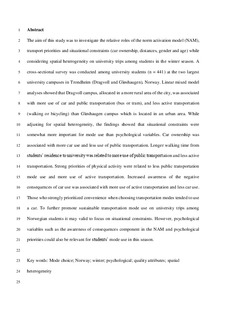| dc.contributor.author | Nordfjærn, Trond | |
| dc.contributor.author | Egset, Kaja Solland | |
| dc.contributor.author | Mehdizadeh, Milad | |
| dc.date.accessioned | 2019-09-20T07:36:16Z | |
| dc.date.available | 2019-09-20T07:36:16Z | |
| dc.date.created | 2019-06-04T19:21:11Z | |
| dc.date.issued | 2019 | |
| dc.identifier.citation | Transport Policy. 2019, 81 45-53. | nb_NO |
| dc.identifier.issn | 0967-070X | |
| dc.identifier.uri | http://hdl.handle.net/11250/2617961 | |
| dc.description.abstract | The aim of this study was to investigate the relative roles of the norm activation model (NAM), transport priorities and situational constraints (car ownership, distances, gender and age) while considering spatial heterogeneity on university trips among students in the winter season. A cross-sectional survey was conducted among university students (n = 441) at the two largest university campuses in Trondheim (Dragvoll and Gløshaugen), Norway. Linear mixed model analyses showed that Dragvoll campus, allocated in a rural area of the city, was associated with more use of car and public transportation (bus or tram), and less active transportation (walking or bicycling) than Gløshaugen campus which is located in an urban area. While adjusting for spatial heterogeneity, the findings showed that situational constraints were somewhat more important for mode use than psychological variables. Car ownership was associated with more car use and less use of public transportation. Longer walking time from students' residence to university was related to more use of public transportation and less active transportation. Strong priorities of physical activity were related to less public transportation mode use and more use of active transportation. Increased awareness of the negative consequences of car use was associated with more use of active transportation and less car use. Those who strongly prioritized convenience when choosing transportation modes tended to use a car. To further promote sustainable transportation mode use on university trips among Norwegian students it may valid to focus on situational constraints. However, psychological variables such as the awareness of consequences component in the NAM and psychological priorities could also be relevant for students’ mode use in this season. | nb_NO |
| dc.language.iso | eng | nb_NO |
| dc.publisher | Elsevier | nb_NO |
| dc.rights | Attribution-NonCommercial-NoDerivatives 4.0 Internasjonal | * |
| dc.rights.uri | http://creativecommons.org/licenses/by-nc-nd/4.0/deed.no | * |
| dc.title | “Winter is coming”: Psychological and situational factors affecting transportation mode use among university students | nb_NO |
| dc.type | Journal article | nb_NO |
| dc.type | Peer reviewed | nb_NO |
| dc.description.version | acceptedVersion | nb_NO |
| dc.source.pagenumber | 45-53 | nb_NO |
| dc.source.volume | 81 | nb_NO |
| dc.source.journal | Transport Policy | nb_NO |
| dc.identifier.doi | 10.1016/j.tranpol.2019.06.002 | |
| dc.identifier.cristin | 1702792 | |
| dc.description.localcode | © 2019. This is the authors’ accepted and refereed manuscript to the article. Locked until 5.6.2021 due to copyright restrictions. This manuscript version is made available under the CC-BY-NC-ND 4.0 license http://creativecommons.org/licenses/by-nc-nd/4.0/ | nb_NO |
| cristin.unitcode | 194,67,40,0 | |
| cristin.unitname | Institutt for psykologi | |
| cristin.ispublished | true | |
| cristin.fulltext | postprint | |
| cristin.qualitycode | 1 | |

